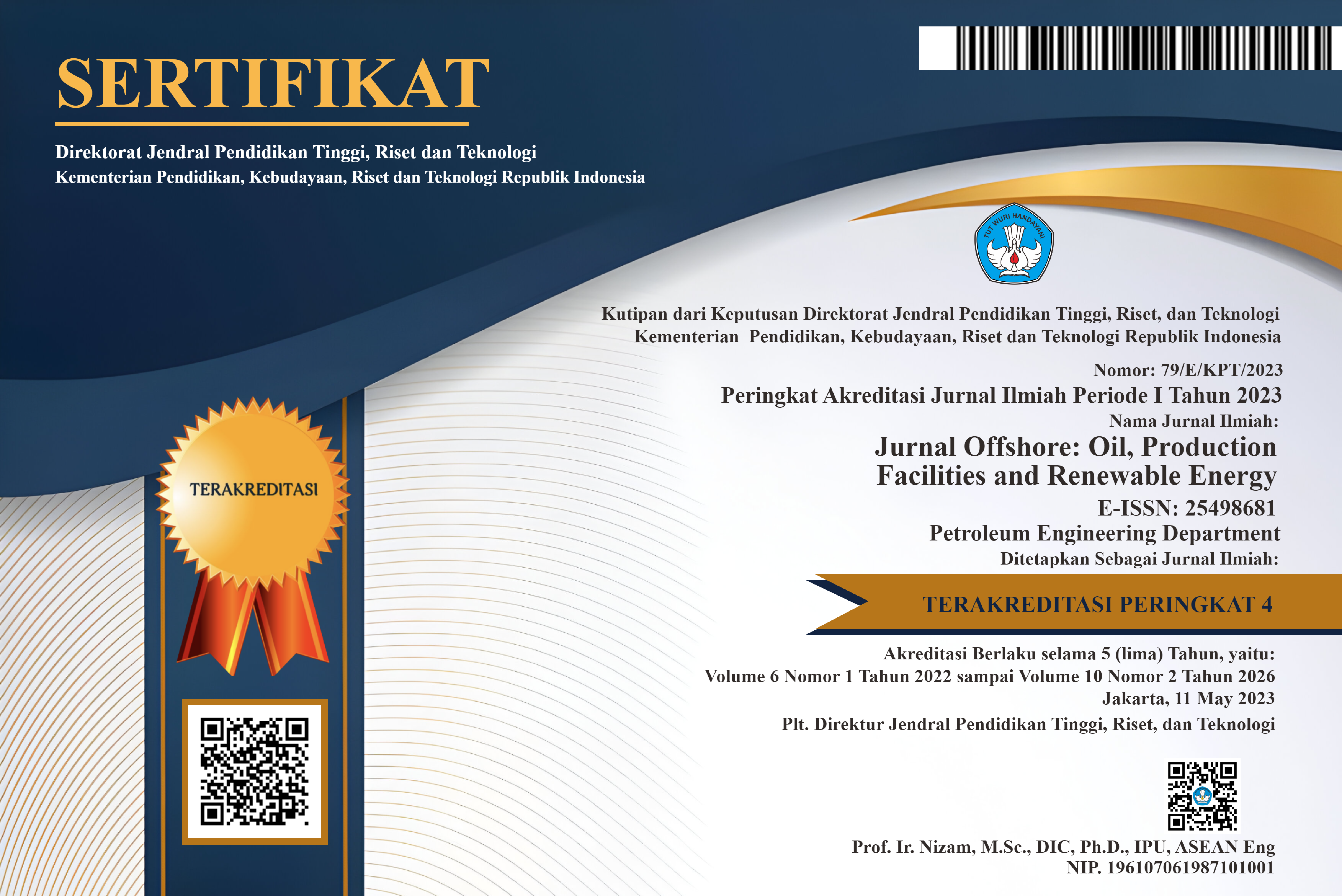Skenario Pengembangan Sumur Injeksi pada Sumber Daya Panas Bumi Sistem Dominasi Air dengan Pemodelan Reservoir 3D Dinamik
DOI:
https://doi.org/10.30588/jo.v3i1.493Keywords:
pemodelan dinamis, penginjeksian panas bumi, pengelolaan reservoir, keberlanjutan, didominasi air, dynamic modelling, reinjection, reservoir management, sustainability, water dominateAbstract
Reinjeksi fluida memiliki peran penting dalam pengelolaan reservoir panas bumi. Reinjeksi bertujuan untuk meningkatkan pengisian alami ke reservoir untuk menjaga tekanan reservoir, produksi uap, dan mengekstraksi lebih banyak panas dari reservoir. Penginjeksian kembali harus direncanakan dengan baik untuk menghindari masalah seperti terobosan termal. Pemodelan dinamis reservoir panas bumi dapat digunakan untuk mengidentifikasi kondisi awal reservoir, karakteristik produksi, dan kinerja produksi reservoir di masa depan. Dalam studi ini, reinjeksi ke reservoir yang didominasi air sintetis direncanakan untuk mempertahankan 55 MW produksi listrik selama 30 tahun. Tujuan dari penelitian ini adalah untuk menentukan strategi injeksi terbaik untuk mencapai produksi listrik selama 30 tahun. Berbagai skenario produksi-injeksi diuji menggunakan pemodelan reservoir panas bumi 3D dinamis. Studi ini menunjukkan bahwa lokasi dan laju injeksi adalah parameter utama dalam strategi injeksi. Sumur reinjeksi terletak di dalam reservoir, tetapi pada jarak yang cukup untuk menghindari terobosan. Suntikan area dekat produksi menyebabkan terobosan dalam sumur produksi. Injeksi pada tingkat yang lebih tinggi memperlambat penurunan tekanan dan meningkatkan produksi cairan secara signifikan.
Reinjection aims to increase the natural recharge to reservoirs in order to maintain the reservoir pressure, steam production, and extract more heat from the reservoir. Reinjection must be well planned to avoid problems such as thermal breakthrough. Dynamic modelling of geothermal reservoirs can be used to identify the future production performance of the reservoir. In this study, reinjection to a synthetic water-dominated reservoir is planned to maintain 55 MW of electricity production for 30 years. The purpose of this study is to determine the best injection strategy. Various production-injection scenarios are tested. The study shows that location and injection rate are the key parameters in injection strategy. The production well are located inside the reservoir, but enough distance to avoid a breakthrough. Near-production area injections are causing breakthrough in production well. Injection at higher rates slows down pressure decline and increase the fluid production significantly.
References
A. Satman, 2010 . Sustainability of a Geothermal Reservoir, in World Geothermal Congress, No. April, pp. 25–29.
M. A. Grant and P. F. Bixley, 2011. Geothermal reservoir engineering, 2nd ed. Elsevier Inc.,
R. DiPippo, 2012. Geothermal Power Plants : Principles , Applications , Case Studies and Environmental Impact, 3rd ed. Elsevier.
G. Axelsson, 2003. Essence of geothermal resource management in Geothermal Training Programme, , no. September, pp. 129–151.
G. Axelsson, 2012. Role and management of geothermal reinjection, Present. “Short Course Geotherm. Dev. Geotherm. Wells”, Organ. by UNU-GTP LaGeo, St. Tecla, El Salvador. March 11-17, 2012., pp. 1–21.
V. Stefánsson, 1997. Geothermal Reinjection Experience, Geothermics, vol. 26, no. 1, pp. 99–139.
P. Ungemach, 2005. Sustainable geothermal reservoir management,… Proc. World Geotherm. …, vol. 33, no. April, pp. 24–29.
A. Franco and M. Vaccaro, 2014. Numerical Simulation Of Geothermal Reservoirs For The Sustainable Design of Energy Plants: A Review,” Renew. Sustain. Energy Rev., vol. 30, pp. 987–1002.
E. Kaya, S. J. Zarrouk, and M. J. O’Sullivan, 2011. Reinjection in geothermal fields: A review of worldwide experience Renew. Sustain. Energy Rev., vol. 15, no. 1, pp. 47–68.
Downloads
Published
How to Cite
Issue
Section
License
Authors retain copyright and grant the Jurnal Offshore right of first publication with the work simultaneously licensed under a Creative Commons Attribution 4.0 International License that allows others to share (copy and redistribute the material in any medium or format) and adapt (remix, transform, and build upon the material) the work for any purpose, even commercially with an acknowledgement of the work's authorship and initial publication in Jurnal Offshore. Authors are able to enter into separate, additional contractual arrangements for the non-exclusive distribution of the journal's published version of the work (e.g., post it to an institutional repository or publish it in a book), with an acknowledgement of its initial publication in Jurnal Offshore. Authors are permitted and encouraged to post their work online (e.g., in institutional repositories or on their website) prior to and during the submission process, as it can lead to productive exchanges, as well as earlier and greater citation of published work (See The Effect of Open Access).















